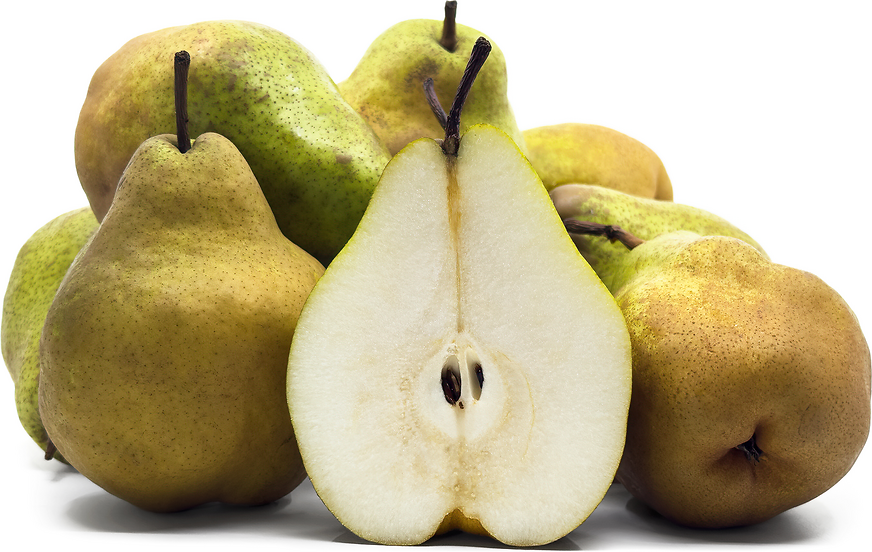


Silver Bell Pears
Estimated Inventory, lb : 0
Description/Taste
Silver Bell pears are a medium to large varietal, averaging 450 to 500 grams in weight, and have the ability to grow as heavy as 800 grams. The fruits have a bulbous, pyriform appearance with a broad, curved base tapering to a slender neck. Silver Bell pears have fibrous, woody, narrow stems and taut, textured, thin skin. The skin ripens from yellow-green to yellow hues and is often covered in patches of brown russet. The surface also bears prominent brown spots or lenticels. These lenticels and russet are natural, edible, and a normal part of the variety. Underneath the surface, the white to ivory flesh is aqueous, smooth, and dense. When ripe, the flesh softens into a melting, succulent consistency. The flesh also encases a central core filled with tiny, black-brown seeds. Silver Bell pears emit a fragrant aroma and should have a slight give around the stem when ripe. The stem may also develop some wrinkling. The fruits are edible after maturity and are known for their high sugar and acidity. This balanced blend creates a refreshing, sweet, and sour flavor with rich, fruity, and floral nuances.
Seasons/Availability
Silver Bell pears are harvested in the early winter, typically around mid-November. Once picked and after a brief storage period, they are sold in commercial markets in the winter through spring, between December and February.
Current Facts
Silver Bell pears, botanically classified as Pyrus communis, are a Japanese variety belonging to the Rosaceae family. The late-season pear was developed from natural mutations found in a La France pear orchard and was chosen for commercial release for its improved characteristics. Silver Bell pears are nicknamed La France’s “little sister” in Japan as they have similar qualities but several distinct differences from the commercially popular Western pear. The variety is favored for its extended shelf life and later ripening time compared to La France. Silver Bell pears are also larger, have a sweet and sour flavor, and transition from yellow-green to yellow when ripe, making it easier to determine maturity. When in season, Silver Bell pears are valued for their rich, refreshing taste and soft, tender flesh. The variety is primarily consumed as a fresh-eating fruit and is sold as a specialty western cultivar throughout Japan.
Nutritional Value
Silver Bell pears have not been extensively studied for their nutritional properties. Pears, in general, are a source of fiber to regulate digestion and polyphenols, which have anti-inflammatory and antioxidant properties. Pears also provide vitamins C and K to strengthen the immune system while aiding in faster wound healing and potassium to balance fluid levels within the body. Other nutrients include calcium and phosphorus to support bones and teeth, iron to develop the protein hemoglobin for oxygen transport through the bloodstream, magnesium to control nerve functions, copper, and zinc.
Applications
Silver Bell pears have a rich, sweet, and sour flavor suited for fresh and cooked preparations. The variety is favored for fresh eating in Japan as it develops a soft, juicy, and melting consistency when ripe. Silver Bell pears are customarily chilled for a few hours before serving as a refreshing snack or dessert. The fruit can also be cut into slices and displayed on fruit plates or chopped and tossed into green salads. In addition to fresh preparations, Silver Bell pears can be simmered into jams, jellies, compotes, and syrups. The variety’s sweet flavoring is also incorporated into various desserts, including cakes, tarts, turnovers, and crumbles. Try poaching peeled Silver Bell pears in a mixture of white wine, lemon juice, sugar, and water as a simple dessert. Silver Bell pears are also occasionally added to beverages like smoothies and cocktails, especially sangria. Silver Bell pears complement mint, rosemary, thyme, chocolate, vanilla, cardamom, cinnamon, ginger, mandarins, pistachios, and almonds. The variety should be kept at room temperature to ripen. Once soft and mature, it can be placed in a plastic bag and stored in the refrigerator’s crisper drawer. It is recommended to immediately consume ripe Silver Bell pears for the best quality and flavor.
Ethnic/Cultural Info
Silver Bell pears were named by breeder Torao Suzuki. It is said that the fruits resembled large bells when hanging on the tree during cultivation, inspiring Mr. Suzuki to name them Bell. Silver was later added as a descriptor to highlight the pear’s arrival during the snowy winter season. Silver Bell pears appear in retail markets in the winter around Christmas, leading them to be named after a popular Christmas decoration. Silver Bells often symbolize joy during Christmas and are typical decorations hung in houses and businesses. Silver Bell pears are also promoted as a seasonal gift for family and friends. Some growers package the bell-shaped fruits in ornate decorative boxes to help position them as a year-end gift.
Geography/History
Silver Bell pears are native to Japan and were developed in the mid-20th century in the Yamagata Prefecture. In 1957, breeders a part of the Yamagata Prefecture Horticultural Experiment Station selected naturally cross-pollinated seedlings found in a La France pear orchard and developed them into a new variety. The natural pear mutations exhibited improved coloring, flavor, and a distinct ripening season from La France pears, making it a choice commercial cultivar to complement the other varieties grown in Yamagata. La France pears are one of the leading pears grown in Yamagata, and the prefecture is known for having the highest production of western pears in Japan. Today, Silver Bell pears are primarily cultivated in the Yamagata Prefecture, which accounts for around 70% of the total production. The variety is also grown in Japan's Iwate and Akita Prefectures and sold through select specialty markets.




